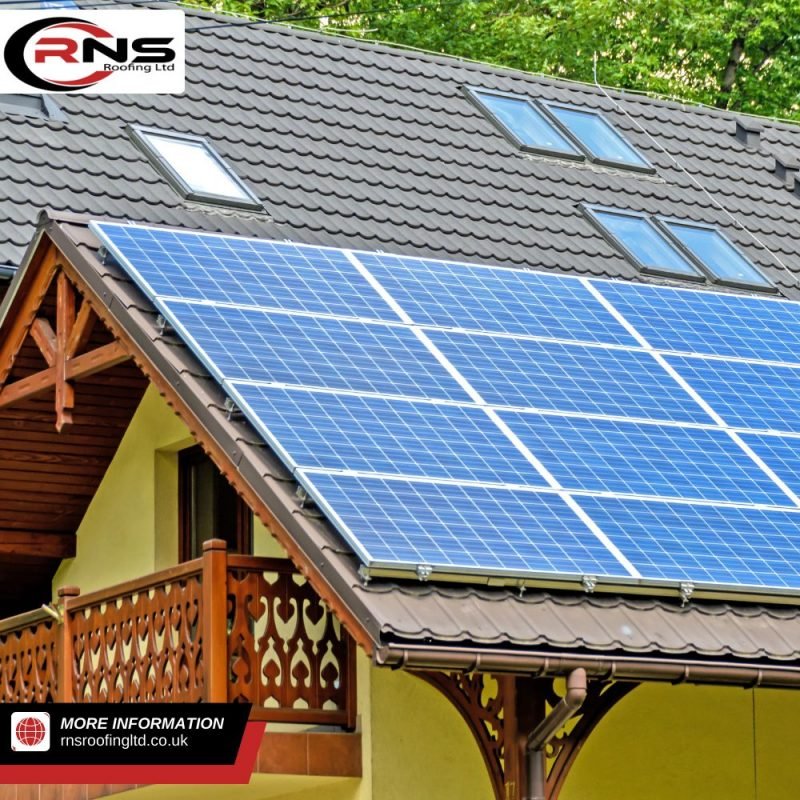As energy costs continue to rise, many homeowners are turning to solar energy as an affordable, environmentally friendly alternative. Installing your solar panels is easier than you think and can significantly reduce your electric bill. You will understand how to install solar panels on the roof by following some simple steps.
Assessing Your Roof’s Solar Potential
To determine if your roof suits a DIY solar panel installation, you must first evaluate its characteristics and conditions. The roof’s orientation, pitch, surface area, and structural integrity are all important factors to consider.
Solar Energy Production from Sun-Surrounding Roofs
A roof’s orientation to the sun is critical. Southerly-facing roofs, especially those tilted at an angle between 30 to 40 degrees, receive the most sunlight over a day and year, making them ideal for maximum energy production. Westerly and easterly-facing roofs can work too, though energy yield may be slightly lower. Northern exposures are typically not well-suited for solar panels.
A Residential Roof Size Guide for a Solar Panel System
The roof’s surface area and available space will determine how large a solar panel system can be installed. Approximately 200 to 500 square feet of roof space is needed for the average household’s typical 3 to 8-kilowatt solar panel system. The roof must also contain obstructions like chimneys, skylights, or attic vents that could shade panels or make installation difficult.
The Influence of Roof Structural Integrity
A roof’s structural integrity is important for supporting the weight of solar panels over the system’s lifetime. Most standard asphalt or composite shingle roofs installed within the last 20 years should be suitable. Still, older or more delicate roof types may require an engineering assessment to ensure they can handle the additional load. If needed, roof repairs or reinforcements can be made to improve its strength and stability before installing panels.
A Simple Step toward Making Your Roof Solar-Ready
Evaluating your roof’s characteristics will help determine if a DIY solar installation is feasible and identify any issues to address to make your roof “solar-ready.” With the right conditions and a little preparation, you’ll be well on your way to harnessing the sun’s energy for your home.
Choosing the Right Solar Panels
You’ll need to install solar panels on your roof to harness the sun’s energy. Choose panels that meet your energy needs and fit your roof size and type.
Crystalline Silicon Panels
The most common and affordable option is made of silicon wafers. They’re 15-20% efficient, converting that percentage of the sun’s energy into electricity.
•Monocrystalline panels have the highest efficiency, around 15-20%, but tend to be the most expensive. They have a distinctive rounded cell shape.
•Polycrystalline panels are slightly less efficient, around 13-16%, but cheaper to produce, with a square cell shape.
Thin-Film Panels
Made of amorphous silicon or Cadmium telluride. They tend to be 10-13% efficient but cheaper and more flexible, suitable for curved roofs. However, they require more roof space for the same power output.
The panels you choose depend on your average electricity usage, roof type, and budget. Calculate to determine the right panel size and type for your needs. With the variety of high-quality, affordable options today, solar power can be an excellent choice for homeowners looking to save money and help the environment. By installing your solar panels, you can gain energy independence and reap the rewards of this renewable energy source for decades.

Obtaining Permits and Incentives for Residential Solar
You must obtain the proper permits and incentives to install solar panels on your roof. This step is crucial to ensure your system is safe, up to code, and eligible for tax credits or rebates.
Permits
Building permits are required for most residential solar installations. These permits ensure that the installation meets safety standards and local building codes. Permits are obtained through your local building department, typically part of your city or county government. The permits required will depend on the specifics of your solar panel system, but will likely include both electrical and structural permits.
Incentives
Federal, state, and local incentives are available for residential solar installations. The main incentives are tax credits, rebates, and net metering.
The Federal Solar Investment Tax Credit
The federal solar investment tax credit (ITC) allows you to deduct 30% of the cost of installing a residential solar energy system from your federal taxes. The ITC applies to solar photovoltaic (PV) and heating and cooling systems.
Solar Panel Installer Reward Program
Many states and utilities also offer solar panel installation rebates or other financial incentives. These rebates will reduce the overall cost of your system. Check with your state energy office and local utility to see the available rebates.
Net Metering Programs for Residential Solar Panels
Net metering programs allow solar panel owners to receive credits for excess energy their panels produce. These credits can be used when your system is not producing enough energy. Most states require utilities to offer net metering programs for residential solar customers. Net metering can significantly offset your electric bills.
Installing Solar Panels on Your Home: Planning for Its Long-Term Benefits
Obtaining the necessary permits and taking advantage of available incentives are important steps to installing solar panels in your home. While the permit process can require time and paperwork, the long-term financial and environmental benefits of going solar make it worthwhile. With some research into your local regulations and programs, you’ll be well on your way to powering your home with the sun.
Hiring Professional Installers vs DIY Installing Solar Panels
When deciding whether to install your solar panels or hire a professional installer, there are several factors to consider. Professionals have the proper training, experience, and equipment to safely and efficiently install a solar panel system. However, hiring professionals can be costly. If you have construction experience and are comfortable working on your rooftops, you may be capable of a DIY solar installation.
DIY Installation
DIY installation can save you a significant amount of money on labor costs. However, there are risks to working on rooftops if you lack experience. You will also need to invest in safety equipment and tools, which can still amount to thousands of dollars. DIY installation may void equipment warranties if not done properly.
Professional Installation
Professionals have the skills and knowledge to optimize panel placement for maximum sunlight exposure and energy production. They can also help determine the ideal system size for your needs and handle paperwork for permits and grid connections. Professional installers typically warranty their workmanship for a period of time after installation.
DIY Electrical System Installation
For many homeowners, the pros of professional installation far outweigh the costs. Professional installation ensures safety, compliance with building codes, and system performance. However, DIY installation is possible for those with construction skills if done carefully. Connecting to your home’s electrical system and the power grid should always be left to professionals to avoid dangerous risks.
In summary, while DIY solar panel installation may save money, professional installation is often the most prudent choice. Professionals have the training, safety standards, and experience to outfit your home with an effective solar energy system properly. They can also help determine the right system design and size to meet your needs. For most homeowners, professional installation provides peace of mind and helps maximize the benefits of going solar.
Step-by-Step Guide to Installing Solar Panel on Roof
Once you have purchased solar panels and the necessary components, you can install them on your roof. Carefully following each step will ensure the panels are securely installed and functioning properly.
Prepare the Roof
Before installing the panels, inspect your roof for leaks or damage and repair as needed. The roof should be less than 10 years old to maximize the system’s lifespan. Clear the area of any debris. You will mount the panels on your south-facing roof, so ensure no obstructions are blocking direct sunlight.
Install the Racking System
The racking system secures the panels to your roof. Install base rails and then attach vertical posts that will hold the panels. Secure everything to your roof following the instructions for your specific system. Use a chalk line to keep the posts straight.
Connect the Panels
Carefully place the first panel in the racking system and secure it with clamps. Connect that panel to the next panel in the row using MC4 connectors to join the wires. Continue adding panels and connecting them until the row is complete. Repeat the same process for any additional rows of panels.
Connect to the Inverter
Run the wires from the solar panels to your inverter. The inverter converts your home’s DC power from the panels to AC power. Connect the wires from the panels to the inverter according to the labels or diagram provided in your inverter instructions. Ensure all connections are tight and secure.
Connect to Your Electrical Service
Connect the output wires from the inverter to your home’s main electrical service panel to provide power to your home. Have an electrician connect the wires to avoid any safety issues. Once connected, your solar panel system will provide free renewable energy and reduce your electric bills!
Following these steps carefully and methodically will ensure your DIY solar panel installation is successful and provides you with energy independence for years to come. Let the power of the sun brighten your day and your wallet.
Conclusion
You now have all the knowledge and tools needed to harness the sun’s power and generate electricity. While the process requires technical skills and physical labor, the rewards of lower energy bills and a greener footprint are well worth the effort. Take your time to ensure each step is done properly and safely. Once your solar panels are operational, you’ll join the growing number of homeowners, achieving greater energy independence and sustainability through solar energy. The sun rises each day to give us a clean, abundant source of power – all you need is the determination to put that power on your roof.
People Ask Questions About How To Install Solar Panels On Roof
How do I determine if my roof is suitable for solar panels?
Start by assessing your roof’s sunlight exposure and checking for any shading from nearby structures or trees. Additionally, considering the roof’s age and condition as a solid foundation is crucial for solar panel installation.
What is the first step in installing solar panels on my roof?
The initial step involves a site assessment by a solar professional. They will evaluate your roof, and shading issues, and calculate your energy needs to design an optimal solar system for your home.
Do I need any special permits to install solar panels on my roof?
Yes, typically. The requirements vary by location, so you must check with your local government or municipality for specific regulations and permits needed for solar panel installations.
Can I install solar panels on a flat roof?
Absolutely! Flat roofs are suitable for solar panel installations. A mounting system is used to angle the panels for better sun exposure in such cases.
Can I put solar panels on the roof?
You can add solar panels to your roof to make electricity from sunlight. Solar panels are flat and capture the sun’s energy to power your home. They’re good for the environment because they don’t pollute, and they reduce the need for harmful fuels. Grown-ups can help you install them on your sunny roof to make your home more eco-friendly and save on electricity bills.

